品质至上,客户至上,您的满意就是我们的目标
技术文章
当前位置: 首页 > 技术文章
Pessl植物生理生态系统:根系加固提高了旱地藜麦的性能、生产力和谷物生物活性质量
发表时间:2022-09-05 10:27:07点击:726
来源:北京博普特科技有限公司
分享:
Pessl植物生理生态监测系统的全套监测系统和在线平台FieldClimate适用于所有气候区,可用于各种行业和各种用途——从农业到研究、水文、气象、洪水警报等。iMetos植物生理生态监测系统已经成为一个全球品牌,使用持续时间更长,性能更好,是通用的天气监测设备,具有早期识别和警报功能(有SMS手机提醒功能);可以用来计划、控制和管理复杂的独立气象过程。该监测系统专为不同气候区域的多种任务而设计。其可以安装多达600个传感器,如土壤和空气湿度、温度、降雨、风速、风向、叶片 湿度、总体辐射等传感器。
Pessl植物生理生态监测系统的数据采集工作站可以将这些数据无线传输到安全的互联网数据库上。该数据库是优秀的数据存储和处理平台。用户获得登录密码后,可以从世界任何地方的互联网终端登录并获得这些数据、报告和图表。测量的信息来源于传感器所在的位置。使用者可以从网站上一个区域可输入或修改阈值和电话号码。操作无需专门软件。
Pessl植物生理生态监测系统仅需要有效的GPRS协议用于数据传输,在站点所在处也需要网络的充分覆盖。该系统是一组多功能、模块化配置的系统,运行完全免维护。该工作站采用太阳能充电电池。工作站可以连接多种传感器。即插即用模式便于工作站扩展传感器数目。

现代农业面临着多重复杂的挑战,必须生产更多的食物和纤维来养活不断增长的人口。越来越多变的天气和干旱等更极端的事件会降低作物产量。这意味着需要大幅增加产量,采用更高效和可持续的生产方法以及适应气候变化。提出了一种新的技术和环境友好型管理技术,以提高藜麦生长至成熟的耐受性,使用天然微生物生物刺激剂(丛枝菌根真菌;AMF)单独、联合或与堆肥(Comp)结合作为有机物质来源在两种水处理(正常灌溉和干旱胁迫(DS)下。与对照相比,DS下生长、籽粒产量和所有生理性状均显着降低,而过氧化氢、丙二醛和抗氧化酶功能显着提高。在DS下,与未经处理的植物相比,生物肥料的应用使生理活动恢复到正常水平,并可能增强藜麦对缺水的适应能力。双重组合使谷物干重提高了 97%。此外,微生物和堆肥生物刺激剂作为生物工具的有效性提高了谷物质量并限制了 DS 下的土壤退化。元素浓度,特别是常量营养素、抗氧化潜力(1,1-二苯基-2-苦基肼自由基清除活性)和生物活性化合物(苯酚和类黄酮含量)在生物肥料处理的藜麦谷物中的积累水平高于未处理的对照。AMF+Comp 对收获后土壤肥力性状的影响最为积极,干旱条件下总磷(47%)和有机质(200%)含量显着增加。总之,我们的数据表明,干旱胁迫强烈影响藜麦的生理特性、产量和质量。微生物和堆肥生物刺激可能是确保更高恢复能力的有效替代方案,从而保持相对较高的谷物产量。我们的研究表明,藜麦的地上应激反应可以通过来自微生物/堆肥处理根的信号进行调节。此外,与未接种和无堆肥的植物相比,使用 AMF 改良和接种的藜麦谷物通常具有更高的营养品质。

Root Reinforcement Improved Performance, Productivity, and Grain Bioactive Quality of Field-Droughted Quinoa (Chenopodium quinoa)
Abstract: Modern agriculture is facing multiple and complex challenges and has to produce more food and fiber to feed a growing population. Increasingly volatile weather and more extreme events such as droughts can reduce crop productivity. This implies the need for significant increases in production and the adoption of more efficient and sustainable production methods and adaptation to climate change. A new technological and environment-friendly management technique to improve the tolerance of quinoa grown to maturity is proposed using native microbial biostimulants (arbuscular mycorrhizal fungi; AMF) alone, in the consortium, or in combination with compost (Comp) as an organic matter source under two water treatments (normal irrigation and drought stress (DS)). Compared with controls, growth, grain yield, and all physiological traits under DS were significantly decreased while hydrogen peroxide, malondialdehyde, and antioxidative enzymatic functions were significantly increased. Under DS, biofertilizer application reverted physiological activities to normal levels and potentially strengthened quinoa’s adaptability to water shortage as
compared to untreated plants. The dual combination yielded a 97% improvement in grain dry weight. Moreover, the effectiveness of microbial and compost biostimulants as a biological tool improves grain quality and limits soil degradation under DS. Elemental concentrations, particularly macronutrients, antioxidant potential (1,1-diphenyl-2- picrylhydrazyl radical scavenging activity), and bioactive compounds (phenol and flavonoid content), were accumulated at higher levels in biofertilizer-treated quinoa grain than in untreated controls. The effects of AMF+Comp on post-harvest soil fertility traits were the most positive, with significant increases in total phosphorus (47%) and organic matter (200%) content under drought conditions. Taken together, our data demonstrate that drought stress strongly influences the physiological traits, yield, and quality of quinoa. Microbial and compost biostimulation could be an effective alternative to ensure greater recovery capability, thereby maintaining relatively high levels of grain production. Our study shows that aboveground stress responses in quinoa can be modulated by signals from the microbial/compost-treated root. Further, quinoa grains are generally of higher nutritive quality when amended and inoculated with AMF as compared to non-inoculated and compost-free plants.
相关阅读
Pessl植物生理生态系统:不同生长习性大豆品种产量与基因型x环境互作
Pessl植物生理生态系统:早疫病预报系统对检测西班牙西北部马铃薯作物首发症状的适用性